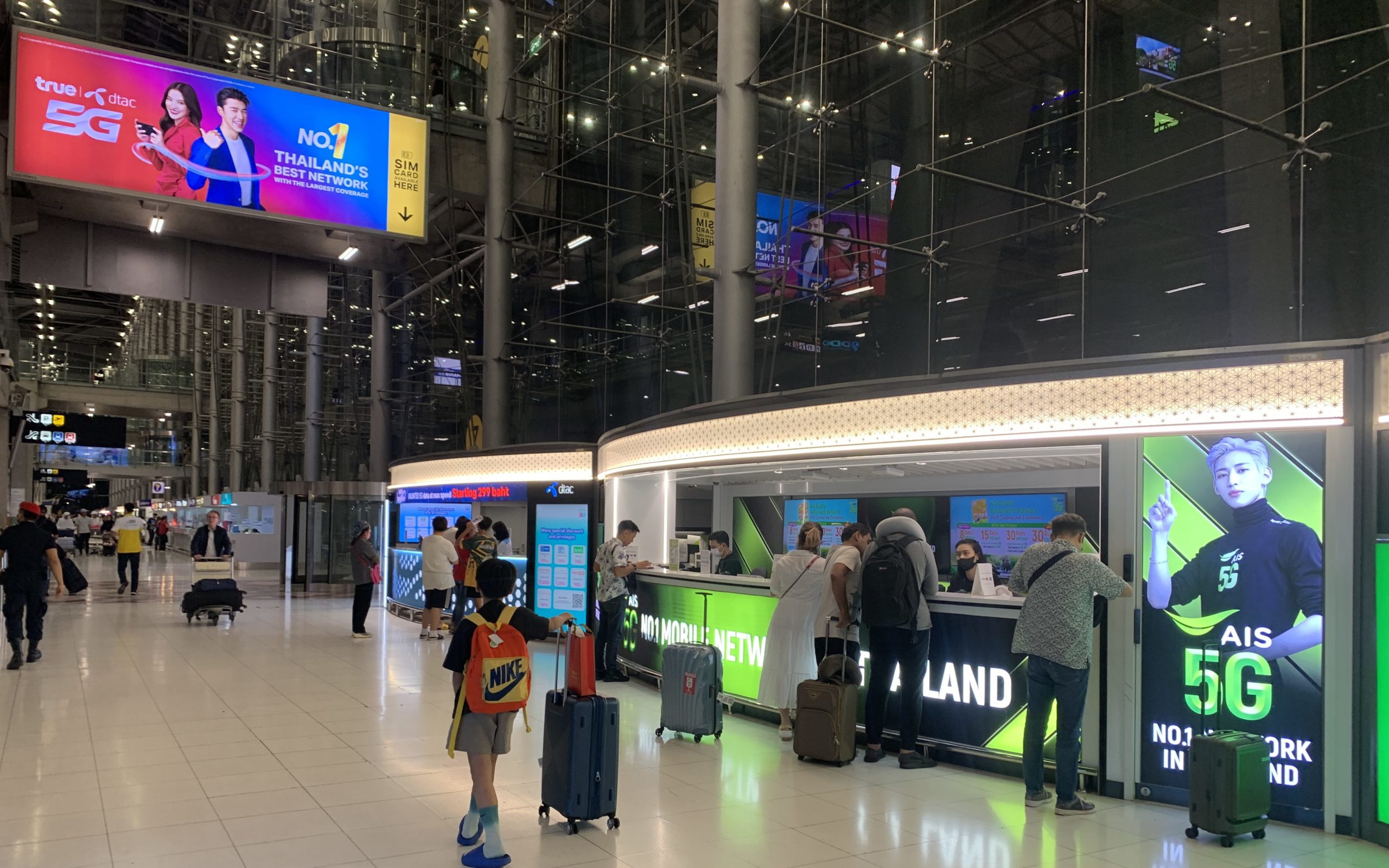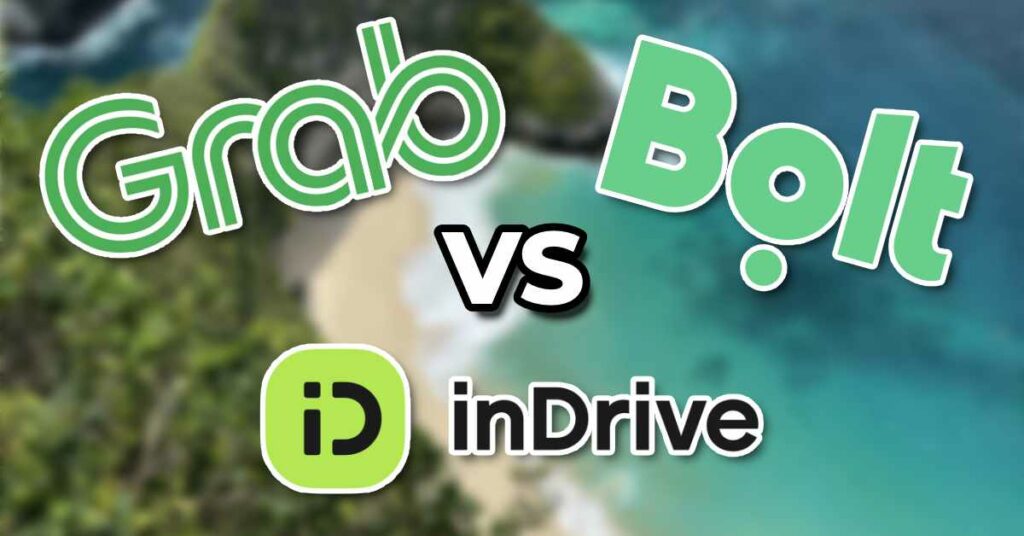Ride-hailing services have become indispensable for both locals and tourists. But which one takes the crown? In our 8-month experience using all three, Bolt offered the most economical and reliable service (for the price), while Grab tends to be pricier but more reliable in rush-hours, harsh-weather conditions, and anything that may surge prices. InDriver, though cheap, lacks in reliability. We’ll dive into why this is the case in the following article.
Grab vs Bolt vs InDriver – Which is Best? (Quick Answer)


Out of the three ridesharing services here’s what is best:
- Bolt (lowest price & reliable)
- 4.5km journey on Bolt price
- 80-100 baht/$2.26-2.83 (no rush hour, no rain)
- 100-200 baht+/$2.83-5.66+ (rainy conditions, rush hour)
- Grab (highest price, most reliable in rush hours)
- 5km ride Grab Taxi price
- 90-120 baht/$2.55-3.39 (no rush hour, no rain)
- 120-250 baht+/$3.39-7.07+ (rainy conditions, rush hour)
- InDriver (cheapest price, but least reliable)
- 5km ride InDrive Taxi price
- 60-100 baht/$2.26-2.83 (no rush hour, no rain)
- 80-200 baht+/$2.83-5.66+ (rainy conditions, rush hour)
After using all three services to get around Thailand, my personal preference leans towards Bolt for its perfect balance between cost and reliability. Grab comes in at a close second due to its excellent service quality, albeit at a higher price. And InDriver in 3rd – because – while offering the cheapest rides, is almost non-existent when you desperately need a lift.
Most drivers tend to accept rides from Grab and Bolt more often because of the higher fares. Even though InDriver takes the lowest commission, inflated fares during rush hour and rainy times make it much more likely for you to get a Grab or Bolt during those moments.
In fact, Grab is far more reliable in those situations from personal experience.
More details below!
Safety and Security – Which is Best?
Most ridesharing apps in South East Asia (especially Thailand) are completely safe. There are not the same issues you might find in Mexico’s Uber, Uber in South Africa, or more dangerous countries. However, you should always still exercise caution when using ridesharing services.
All apps are completely safe and include reviews and in-depth profiles of drivers which will give you confidence in the safety of your drives.
Personally, I’ve been on a 5hr trip and a 10hr round-trip using Bolt and everything was completely safe. My ride was fantastic, the car they used was new (if you go on larger trips, they generally send better cars), and the driver was very friendly. We had great conversations and stopped at many service stations along the way for nourishment, food etc.
Here are the safety measures incorporated by Bolt, Grab, and InDriver:
- Grab incorporates safety measures like driver background checks and an in-app emergency button.
- Bolt also has similar features, ensuring riders’ safety with verified drivers and an SOS feature in the app.
- InDriver is somewhat behind in this regard; although it has some safety measures, they aren’t as comprehensive as Grab or Bolt.
Pricing of Grab, Bolt & InDriver





Grab tends to be the priciest among the three, especially for long-haul journeys. Bolt, on the other hand, is often cheaper and equally reliable. InDriver allows riders to negotiate the fare, making it potentially the cheapest but least reliable option.
Bolt is definitely the best on price here for both short journeys and long journeys. For instance (in the 4hr journey above), I paid around $38 on Bolt; prices on Grab were 2x this, so I would have ended up paying almost $80 for the same trip. I don’t know about you, but I’d rather save that money and tip the Bolt driver, then he gets more cash without having to pay commission to Bolt or Grab.

In some cases, you might still want to opt for Grab, especially during surge price times. For instance, when it rains heavily in South East Aisa, prices rocket, and so does the demand for taxis. It’s almost impossible to get a Bolt during these times. This is for 2 reasons, the demand is extremely high, and Grab charges considerably more during rainy and harsh conditions.
In this case, it’s better to use Grab because they have the most extensive fleet available.
Reliability
When I used all three for 8 months in Aisa, here’s what I found:
Bolt was highly reliable, with many active drivers and a review system that kept the service in check. Grab was also reliable but fell short when it came to higher pricing (particularly during peak hours when surge prices could be exorbitant). However, they had the most active drivers, making it the best to use in those conditions. InDriver was virtually a no-show, making it the least reliable among the three.
I would suggest using Bolt most of the time you can, and when it gets busy, just pay the extra on Grab so you don’t have to wait around in torrential rain!
Service Offerings
In the realm of ride-hailing and delivery services, Grab stands out by offering a comprehensive range, including ride-hailing, food delivery, and parcel delivery. You can send an item across town on demand using Grab, which can be very useful at times. When you’re checking into AirBnb, often hosts will send you the keys using this delivery service.
Bolt, on the other hand, primarily focuses on ride-hailing but extends its reach to food delivery in select regions.
I have yet to use their food service and didn’t find it active in any region I traveled. To combat this I used Grab or Food Panda (the two most popular).
In contrast, inDriver focuses solely on taxis and does offer food delivery or package delivery. While Grab leads in terms of services offered, Bolt’s competitive pricing and inclusion of food delivery make it a strong alternative, while inDriver remains limited to ride-hailing.
Using Ridesharing From Airports

To take a ridesharing app from the airport, you often have to walk from the main taxi pick-up zone. This can sometimes be quite a long walk with all your luggage, especially if it’s heavy and you’ve just come off a long flight. However, the price differences can be huge if you do this as metered taxis generally charge a bit more.
If you’re a budget backpacker I’d suggest you walk to the carpark area of the airport or outside the main pick-up and drop-off points as this will save money. Especially when you’re in a group of more than 6, you can order a minivan to come to pick you all up, saving on the cost massively.
Unfortunately Grab, Bolt, and InDriver don’t have designated pick-up points at any airports yet (like Uber does in some parts of the world). If this is a problem for you, get a metered taxi, they’re not an incredible amount more.
Metered Taxis are readily available right outside the terminal. Other options include buses and metro services, which are significantly cheaper but less convenient.
On That Point… Metered Taxis – Are They Worth Using?
Metered taxis can be convenient but are usually more expensive than Bolt and sometimes even Grab. However, they offer the advantage of immediate availability right outside the airport terminal, and they’re always floating around cities so you can just wave one down, jump in and go.
If you do get a metered taxi, beware of dishonest drivers who don’t put the meter on or make try to make you pay tourist tax. You can check the rough cost of a journey on Grab beforehand. Expect a metered taxi to be slightly more expensive than what’s shown on Grab by 100-200 baht ($5-$10).
Which Does My Driver Earn More From?
When comparing the earnings of rideshare drivers on Bolt, Grab, and inDriver, it’s important to consider the commission rates. These will directly affect how much your driver is earning and some apps are more generous than others. If this is something you’re conscious about, then I’ll leave the rates below for you.
Here’s how much commission Grab, Bolt and InDrive charge their drivers:
- Bolt – charges drivers a commission in the range of 15% to 20% of the fare. The exact rate may depend on the city and other factors, but generally, Bolt is known for having lower commission rates compared to some competitors.
- Grab – commission rates can vary but often fall within the range of 20% to 25%. Like Bolt, the specific commission rate can differ by city or region, but they are generally higher on Grab for drivers.
- inDriver – uses a unique model where drivers set their own fares, and the platform doesn’t impose a fixed commission rate. Instead, inDriver charges a small service fee to passengers, and drivers retain the amount they negotiated with the passenger. The absence of a set commission allows drivers more flexibility in determining their earnings.
It’s important to note that these commission rates are approximate and can change over time, especially in response to competitive pressures and market conditions. For the most up-to-date information on commission rates, you can check the relevant pages on the links above.
The Summary
Based on a comprehensive look at pricing, safety, reliability, and other factors, Bolt stands out as the winner for ride-hailing in Asia. It offers an optimal blend of affordability and reliability without compromising on safety features. Grab comes in at a close second, offering excellent services but at a steeper price. InDriver, although the cheapest, suffers from a lack of reliability and is therefore not recommended for time-sensitive journeys. For most people, Bolt will offer the best balance of cost, convenience, and safety.

I’m Harry – and I was tired of the same old “10 best places I’ve never been but I’m writing about for some reason” blog posts. So… I’m a young traveller on a mission to travel the world and share my true, unfiltered experience, including all the gristly details. From packing my life into one bag for a year, to traveling Vietnam by motorbike, to sorting out Visas for specific countries – I’ve done it all, am doing it all and only give my advice on things I have done – not regurgitated cr*p from another source *cough* most publications *cough*. So bear with us! This project will take some time to grow, and will take a fair bit of money. But I’m determined to make it the single best source of information about traveling on the internet.


